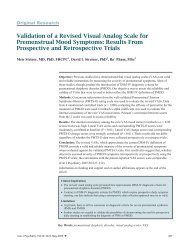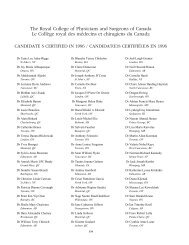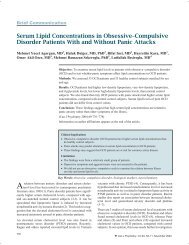The Canadian Journal of Psychiatry - Canadian Psychiatric ...
The Canadian Journal of Psychiatry - Canadian Psychiatric ...
The Canadian Journal of Psychiatry - Canadian Psychiatric ...
Create successful ePaper yourself
Turn your PDF publications into a flip-book with our unique Google optimized e-Paper software.
<strong>The</strong> <strong>Canadian</strong> <strong>Journal</strong> <strong>of</strong> <strong>Psychiatry</strong>—Original Research<br />
Table 3 Pearson correlations (significance) between facial muscle tension changes and PANSS<br />
syndromes, schizophrenia sample (n = 32); 2-tailed<br />
M. orbicularis oculi M. levator labii M. zygomaticus major<br />
PANSS positive syndrome 0.39* 0.30** 0.42*<br />
PANSS negative syndrome –0.36* –0.24 –0.26<br />
PANSS cognitive syndrome –0.00 0.06 0.06<br />
PANSS depressive syndrome –0.36* –0.34** –0.33**<br />
PANSS excitement syndrome 0.00 0.09 0.05<br />
*P < 0.05; **P < 0.1<br />
in smile reactions. <strong>The</strong>se results were independent from the<br />
etiology, and therefore similar in depression and schizophrenia<br />
patients.<br />
Another important finding <strong>of</strong> our study is the correlation<br />
between the POS syndrome and the increase in M. levator<br />
labii activity. With the use <strong>of</strong> the FACS, Steimer-Krause measured<br />
an increased activity <strong>of</strong> Action Unit 9 in patients with<br />
schizophrenia (21). Action Unit 9 activity is caused by the<br />
activity <strong>of</strong> M. levator labii and—according to Ekman and<br />
Friesen (4–6)–is an expression <strong>of</strong> disgust or contempt.<br />
Steimer–Krause believes this finding to be specific for schizophrenia<br />
patients and discusses it as a protection against closeness.<br />
We disagree, since the previsible activity <strong>of</strong> the M.<br />
levator labii, when measured with a facial EMG method such<br />
as ours, is not a specific expression <strong>of</strong> disgust, as proven in a<br />
recent study (15).<br />
One possible explanation for the correlation <strong>of</strong> the positive<br />
syndrome and the increased activity <strong>of</strong> the M. levator labii<br />
superioris might be the mimic disintegration, as proposed by<br />
Heimann and Spoerri (2,3). <strong>The</strong>y investigated whether it is<br />
possible to identify mimic disintegration in unmedicated<br />
schizophrenia patients. Mimic disintegration is defined as the<br />
inability to organize the singular facial muscle movements in<br />
such a way that they present an integrated whole. Mimic disintegration<br />
makes it difficult for observers to decode the emotional<br />
state, since these facial actions seem indecipherable and<br />
bizarre. Without a sufficient decoding <strong>of</strong> the emotional state<br />
<strong>of</strong> the person in front <strong>of</strong> you, it is difficult to establish contact<br />
or to develop a deeper relationship with him or her. <strong>The</strong> link<br />
between mimic disintegration and M.levator labii activity was<br />
further supported by another recent study (32).<br />
To understand these results in depth, it is necessary to collect<br />
larger samples, to distinguish between the different types <strong>of</strong><br />
smiles, and to further investigate the correlation between<br />
mimic disintegration and psychopathology. To understand<br />
the etiology <strong>of</strong> the reduced FEE, it would also be necessary to<br />
include eye tracking. Our present results recommend further<br />
studies <strong>of</strong> schizophrenia patients, especially in regard to the<br />
positive and negative syndromes, using an EMG method that<br />
allows the simultaneous measurement <strong>of</strong> up to 10 facial muscles.<br />
Such a broad measurement would allow the analysis <strong>of</strong><br />
other emotions like appetence, disgust, pain, or fear—<br />
emotions that might be affected in schizophrenia patients as<br />
well. In this context, studies comparing the effect <strong>of</strong><br />
antipsychotics are <strong>of</strong> great importance, since the effects <strong>of</strong><br />
antipsychotics on FEE are largely unknown.<br />
Funding and Support<br />
This study received no funding or support.<br />
References<br />
1. Kraepelin E. Psychiatrie: ein lehrbuch für studierende und ärzte. Leipzig: Barth;<br />
1883.<br />
2. Heimann H, Spoerri T. Das ausdruckssyndrom der mimischen desintegrierung<br />
bei chronischen schizophrenen. Schweiz Med Wochenschr 1957;Suppl:1126 –32.<br />
3. Heimann H. Die quantitative analyse mimischer bewegungen und ihre<br />
anwendung in der pharmako-psychiatrie. Arzneimittelforschung 1966;16:294 –7.<br />
4. Ekman P, Friesen WV. <strong>The</strong> Facial Acting Coding System: a technique for the<br />
measurement <strong>of</strong> facial movement. Palo Alto (CA): Consulting Psychologists<br />
Press; 1978.<br />
5. Ekman P. Darwin and facial expression. New York: Academic Press; 1973.<br />
6. Ekman P. Emotion in the human face. 2nd ed. Cambridge: University Press;<br />
1982.<br />
7. Baenninger-Huber E. Mimik – übertragung – interaktion: die untersuchung<br />
affektiver prozesse in der psychotherapie. Bern: Huber; 1996.<br />
8. Katsikitis M. <strong>The</strong> quantification <strong>of</strong> smiling using a microcomputer-based<br />
approach. <strong>Journal</strong> Of Nonverbal Behaviour 1990;14:3–17.<br />
9. Pilowsky I, Katsikitis M. <strong>The</strong> classification <strong>of</strong> facial emotions: acomputer-based<br />
taxonomic approach. J Affect Disord 1994; 30:61–71.<br />
10. Thornton M, Pilowsky I. Facial expressions can be modelled mathematically.<br />
Br J <strong>Psychiatry</strong> <strong>Psychiatry</strong> 1982;140:61–3.<br />
11. Dimberg U. Facial reactions to facial expressions. Psychophysiology<br />
1982;19:643–7.<br />
12. Dimberg U. Facial electromyography and the experience <strong>of</strong> emotion.<br />
Psychophysiology 1988;3:277–82.<br />
13. Dimberg U. Facial electromyography and emotional reactions.<br />
Psychophysiology 1990;27:481–94.<br />
14. Dimberg U. Rapid facial reactions to emotional facial expressions. Scand J<br />
Psychol 1998;39:39–45.<br />
15. Wolf K, Mass R, Kiefer F, Naber D, Wiedemann K. <strong>The</strong> facial pattern <strong>of</strong> disgust,<br />
appetence, excited joy and relaxed joy – an improved facial EMG study. Scand J<br />
Psychol 2005; 46:403–9.<br />
16. Wolf K, Mass R, Kiefer F, Naber D, Wiedemann K. <strong>The</strong> face <strong>of</strong> pain – a pilot<br />
study to validate the measurement <strong>of</strong> facial pain expression with an improved<br />
electromyogram method. Pain Res Manag 2005;10:15–9.<br />
340<br />
Can J <strong>Psychiatry</strong>, Vol 51, No 6, May 2006







